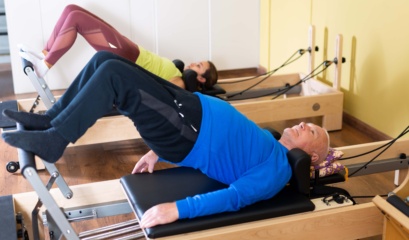If you want to learn how to fix your posture, you’re in the right place. Nowadays, many of us spend hours every day hunched over screens or engaged in activities that don’t support our spine’s natural curves. This makes having good posture harder than ever. From the subtle forward head posture, often a byproduct of staring at our devices, to more pronounced concerns like sway back, stooped posture, and kyphosis, the range of postural issues is vast and varied.
Each of these conditions not only affects our physical appearance but can also lead to a number of health challenges, impacting our daily lives and long-term health. Recognising and addressing these common posture problems is the first step towards a pain-free, active, and healthy lifestyle.
From humble beginnings in 1984, all the way up to 5 practices located across South-West and East Sydney, Benchmark Physiotherapy has grown into a group of practices that prides itself on helping people to stay healthy, active and live life to the fullest. So if you’re in Sydney and want help with your posture, contact us today.
Causes of Bad Posture
1. Postural Weaknesses
When we think about bad posture, we often visualise someone slouching over in a hunched position. In this position some muscles begin to work harder (and longer) than they should or are designed to. Other muscles may become shortened and tight (adaptive shortening). This may place an increased strain on passive structures. Here are some examples of postural weaknesses.
Increased Thoracic Kyphosis
- Exaggerated curvature of the upper back
- Common cause of pain in the scapula region

Reduced Lumbar Spine Lordosis
- Pelvis posteriorly rotated. This flattens the lumbar spine and can cause lower back pathology including disc pathology, acute nerve root (sciatica) and degeneration

Rounded Shoulder Posture
- Shoulders are pulled forward
- Can contribute to shoulder pain as well as neck and upper back pain

2. Increased Sedentary (Seated) Work Hours
Advances in technology have led to many of us sitting hours at a time, looking at a computer screen, doing the same movements again and again, sometimes with not even a window in sight to look outside to see the view. Demanding jobs leave us not having time to regularly get up throughout the day, stretch our legs or even take a walk. And spending our lunch break at our desk working is all too common.
Prolonged sitting reduces body movement making muscles more likely to pull, cramp and strain and causes fatigue in the back and neck muscles. Too much sitting plays an important part in bad posture.
3. Poorly Designed Workstations
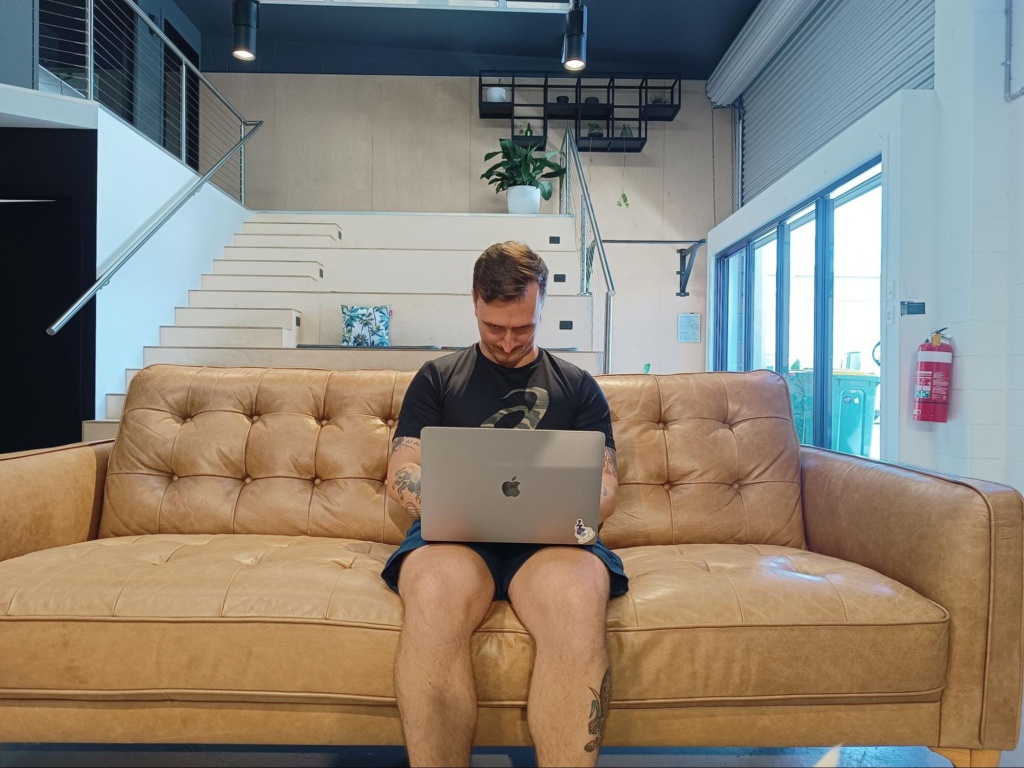
A poorly designed workstation such as an incorrectly positioned computer or chair can lead to fatigue, discomfort, lack of productivity and injury. Many people aren’t aware that their headaches, neck pain and back pain may be caused by their workstation setup.
Fundamentals of Good Posture
Mastering the basics of good posture, especially at work, mitigates the risks associated with bad posture and helps ensure overall health. Whether sitting or standing, maintaining proper posture is essential.
9 Tips for Good Sitting Posture
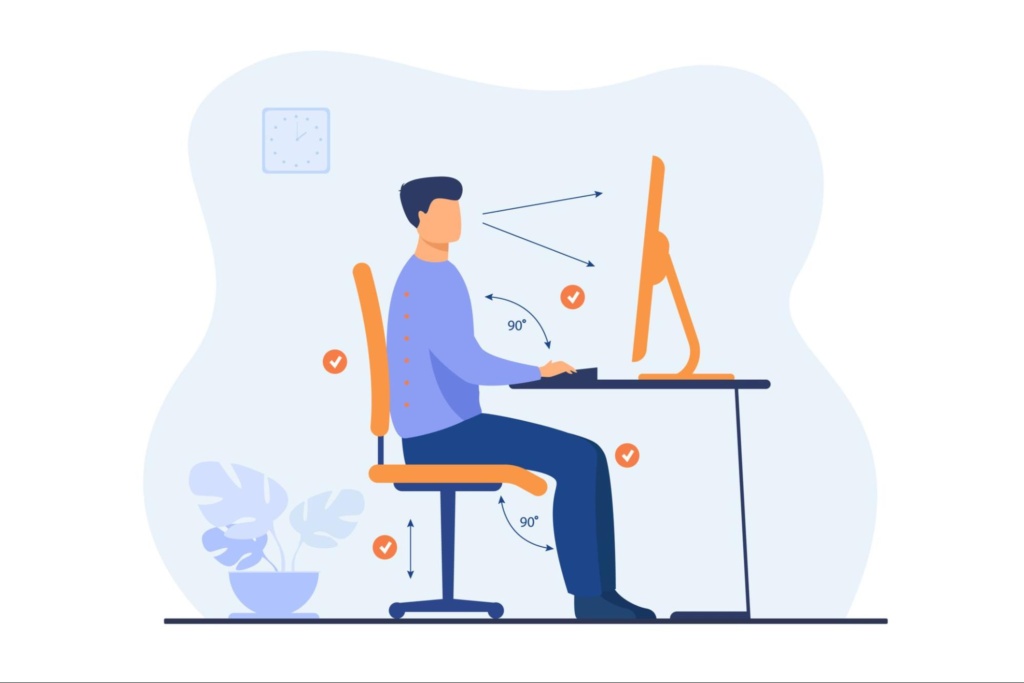
Achieving the right sitting posture, especially if you spend long hours at a desk, is crucial for your overall spinal health and comfort. Here are some key aspects to consider:
1. Chair and Desk Height
- Your chair height should be adjusted so that your feet rest flat on the ground or on a footrest, with your thighs parallel to the floor.
- Ensure your desk height allows your elbows to rest comfortably at a 90-degree angle, keeping your shoulders relaxed.
2. Keyboard and Mouse Position
- Position your keyboard and mouse within easy reach. Your wrists should be straight, your hands at or slightly below elbow level.
- Consider using ergonomic keyboards or mouse pads with wrist support to reduce strain.
3. Breathing Technique
- Practice diaphragmatic breathing – breathe deeply from the diaphragm rather than shallowly from the chest. This helps reduce tension and promotes relaxation.
4. Vision and Squinting
- Your computer screen should be at an arm’s length away and the top of the screen at or slightly below eye level. This prevents you from leaning forward or squinting to see the screen.
5. Leg Position
- Avoid crossing your legs or ankles as this can lead to posture imbalances and reduced blood flow. Instead, keep your feet flat on the floor or on a footrest.
6. Use a Headset
- If your work involves frequent phone use, use a headset or speakerphone. This avoids the need to cradle the phone between your head and shoulder, which can strain your neck muscles.
7. Alternatives like Standing Desks
- Consider using a standing desk, or an adjustable desk that allows you to alternate between sitting and standing. Standing desks can help reduce the strain on your back and encourage better overall posture.
8. Use a Lumbar Roll
- Using a lumbar roll or a small cushion positioned at the curve of your lower back can provide essential support to your lumbar spine. This helps maintain its natural curve and prevents slouching.
- Adjust the lumbar roll to ensure it feels comfortable and supportive without pushing your torso too far forward. It should promote a natural, upright posture rather than forcing your spine into an exaggerated arch.
9. Get Moving!
- Take breaks and step away from your desk. A brief walk or a quick run can counteract the effects of prolonged sitting.
- These activities do more than just stretch your muscles; they enhance circulation, boost energy, reduce stress, and contribute to overall muscle strength and mobility. This not only aids in maintaining a healthy posture but also enriches your overall well-being.
7 Tips for Good Standing Posture
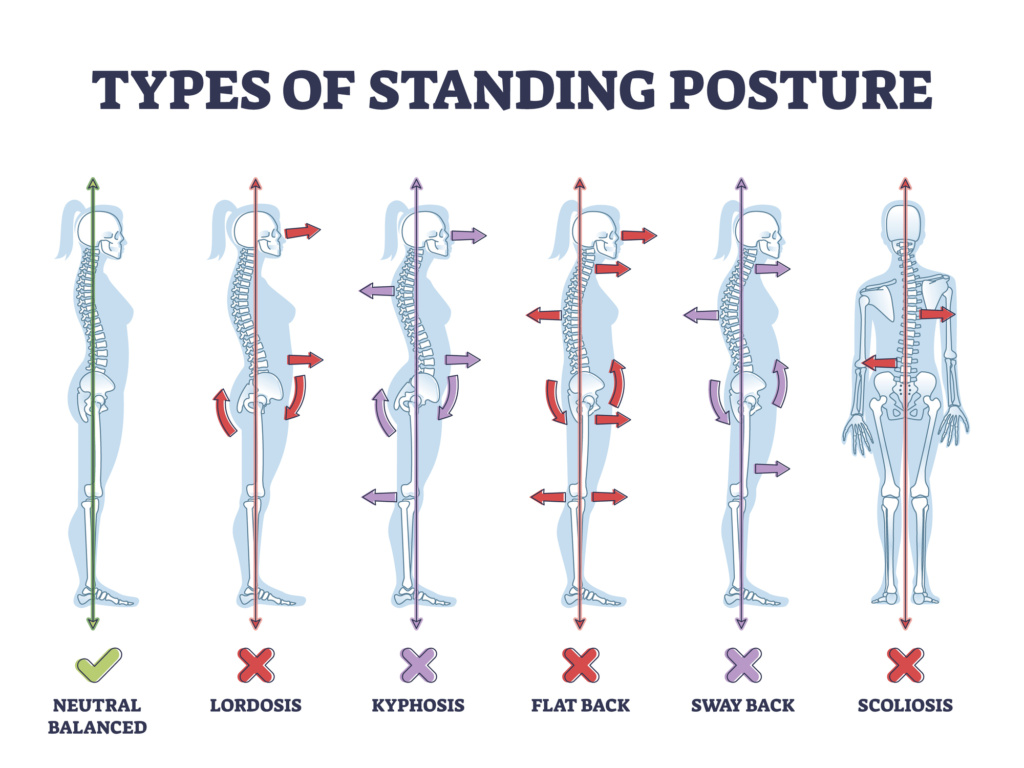
1. Stand Tall and Straight
- Keep your shoulders pulled back, enhancing your stature and ensuring your spine is aligned. This helps in reducing unnecessary strain on your back muscles.
2. Head Alignment
- Your head should be level and in line with the rest of your body, not tilted forward or backward. This alignment reduces the strain on your neck and shoulders.
3. Engage Your Core
- Gently pull in your abdomen. This engagement supports your lower back and helps in maintaining a neutral spine position.
4. Foot Position
- Keep your feet about shoulder-width apart, providing a stable base for your body. This stance helps in evenly distributing your weight and aids in overall balance.
5. Knee Position
- Avoid locking your knees, as this can cause discomfort and even lead to joint strain. Instead, keep your knees slightly bent to maintain flexibility and circulation.
6. Weight Distribution
- Aim to bear your weight primarily on the balls of your feet. This helps in maintaining balance and reduces fatigue.
7. Arm Placement
- Let your arms hang naturally at your sides. Avoid crossing your arms or putting your hands on your hips, as these positions can lead to muscle imbalances and affect your posture.
The Impact of Posture on Overall Health
Physically, poor posture can lead to a series of chain reactions in the body. This is especially true when combined with a sedentary lifestyle. When the spine is not properly aligned, it can cause imbalances in muscle strength and flexibility, leading to decreased mobility and increased susceptibility to injuries. For instance, a forward head posture can strain the cervical and thoracic spine, disrupting its natural curve and leading to chronic neck pain and headaches. Similarly, a stooped posture can restrict lung capacity, impeding proper breathing, and potentially affecting cardiovascular health.
The relationship between posture and cervicogenic headaches is particularly noteworthy. These headaches, often stemming from issues in the neck or cervical spine, are frequently linked to muscle tension and joint strain in the neck and upper back, which can be direct results of poor posture. Ranging from a dull, aching discomfort to severe pain, cervicogenic headaches can profoundly impact daily life and activities.
Surprisingly, bad posture can even affect your mental state. There’s a bidirectional relationship between posture and mood. Poor posture can lead to decreased self-esteem and increased feelings of depression and fatigue. It can affect body language and, subsequently, how individuals perceive themselves and are perceived by others. Adopting an upright, open posture can enhance mood, boost confidence, and even improve stress resilience.
Exercises to Correct and Improve Posture
Regular exercise is key to improving posture and alleviating issues arising from poor alignment. Here are some targeted exercises designed to strengthen key muscle groups and promote better posture:
1. Seated Thoracic Extensions
Seated thoracic extensions are a great exercise for improving the mobility of your upper back. They’re particularly useful as you can perform them from your office chair! This exercise helps in relieving stiffness and promoting better spine alignment.

- Sit upright in a chair with your feet flat on the floor and your knees at a 90-degree angle.
- Place your hands behind your head, interlocking your fingers, with your elbows wide.
- Gently arch your upper back backwards, focusing on extending the thoracic (upper) spine.
- Hold the extended position for a few seconds, feeling a gentle stretch in your upper back.
- Return to the starting position and repeat the movement for 8-10 repetitions.
- This exercise should be performed smoothly and without strain, ensuring a focus on the thoracic region rather than the lower back.
2. Shoulder Blade Squeezes
The shoulder blade squeeze strengthens the muscles between your shoulder blades, improving upper back posture.
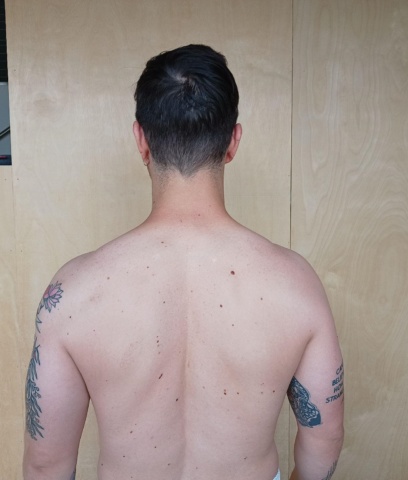
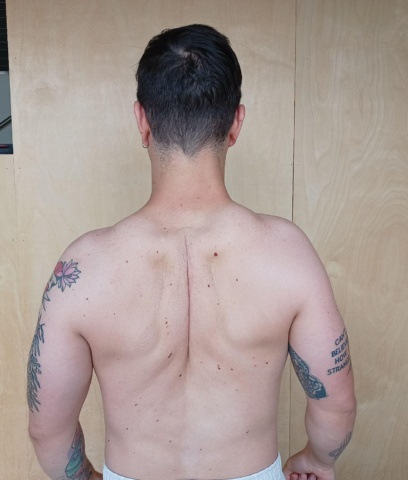
- Stand up straight with your arms at your sides.
- Squeeze your shoulder blades together.
- Hold for 5 seconds and release.
- Repeat 10 times.
3. Chest Stretch
Open up the chest and counteract the rounded shoulders posture.

- Stand in a doorway with your arms raised, elbows bent so your forearms are parallel to the floor.
- Place your hands on the door frame.
- Step forward with one foot and lean into the stretch. You should feel a stretch in your chest and front of shoulders.
- Hold for 20-30 seconds. Repeat 2-3 times.
4. Chin Tucks
Chin tucks strengthen the neck muscles and promotes a better alignment of the head.


- Sit upright in a chair or stand with your shoulders relaxed.
- Gently tuck your chin in, as if making a double chin.
- Hold for 5-10 seconds.
- Repeat 10 times. Perform several sets throughout the day.
5. Upper Trapezius and Levator Scapula Stretch
This is just a fancy name for a basic neck stretch. The upper trapezius/levator scapula stretch is a simple yet effective exercise to relieve tension and tightness in the neck and shoulder area.

- Sit or stand comfortably with your body relaxed.
- Gently tilt your head to one side, bringing your ear towards the shoulder, while keeping the opposite shoulder still and lowered.
- For a deeper stretch, you can gently place your hand to the back of the head and apply a little extra pressure, ensuring not to strain.
- Hold this position for 20-30 seconds, feeling a stretch on the side of your neck.
- Slowly return to the starting position and repeat on the other side.
- This stretch should be done gently and without forcing the neck into uncomfortable positions. It’s ideal for regular breaks throughout the day, especially for those with desk jobs.
6. Lying Lumbar Extension
Lying lumbar extensions are a beneficial exercise for strengthening the lower back and improving lumbar spine mobility. This exercise is especially useful for individuals who experience lower back stiffness or pain.
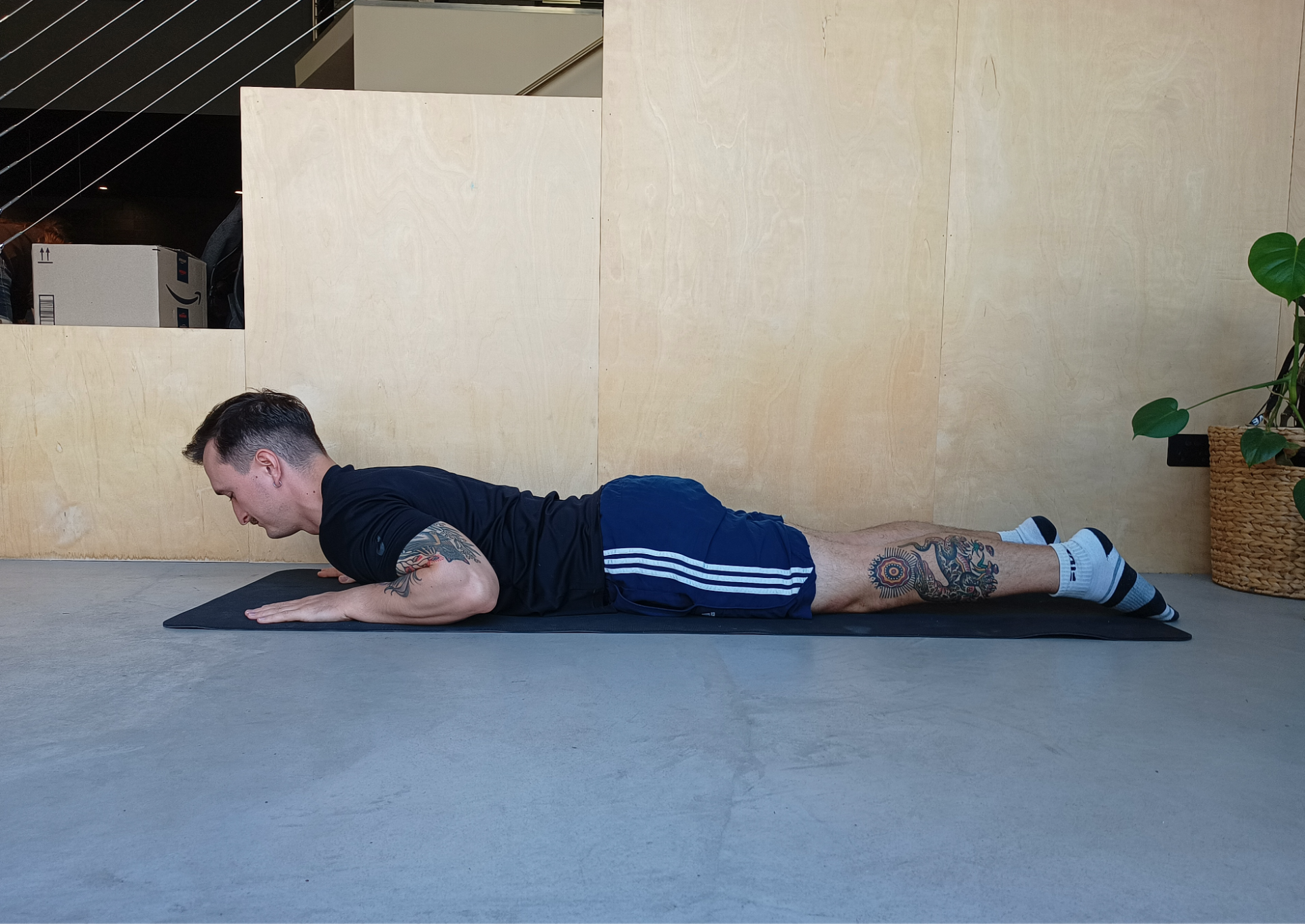
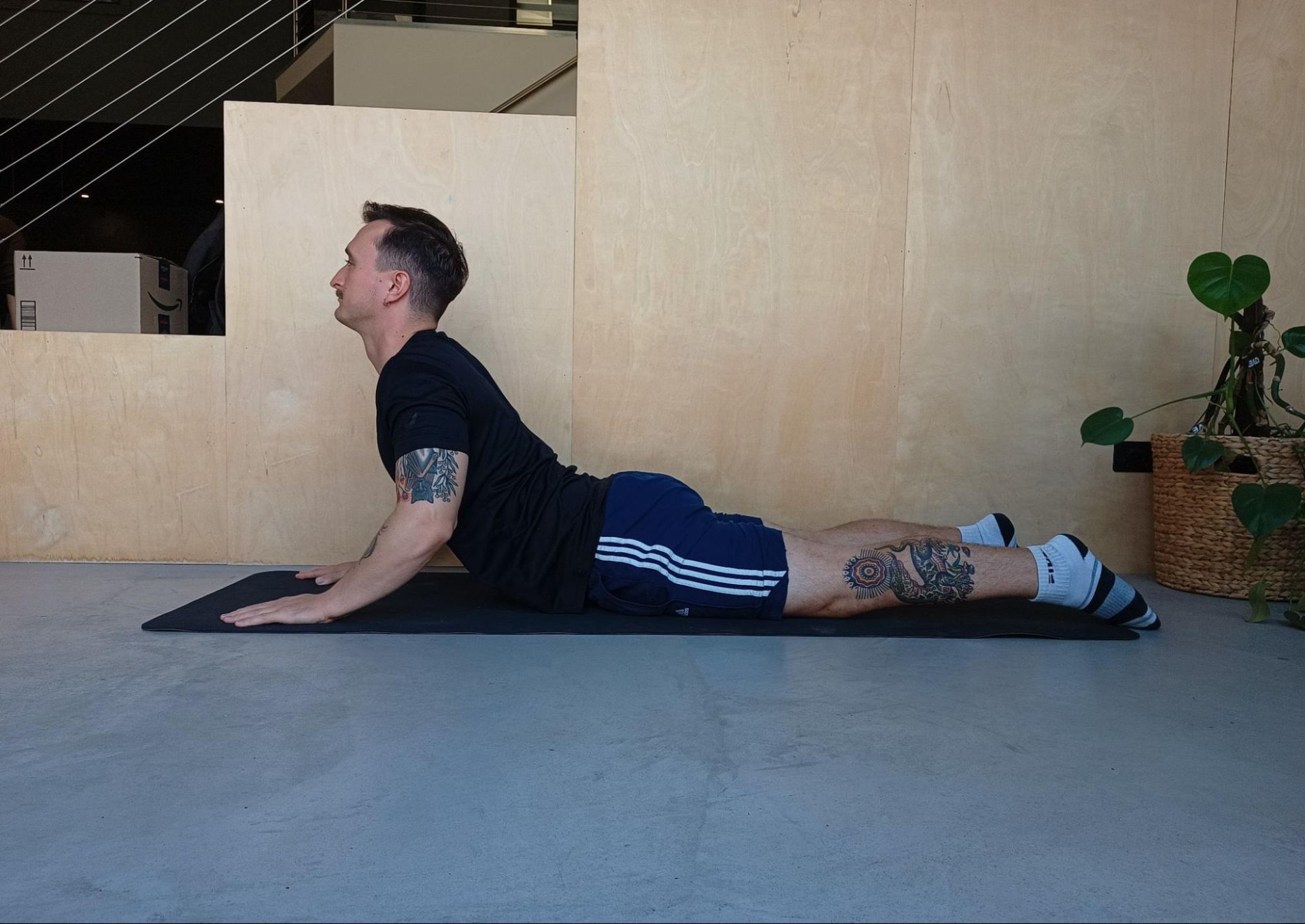
- Lie face down on a yoga mat (or just the floor)
- Place your elbows directly under your shoulders and prop yourself up on your forearms, relaxing your stomach muscles.
- Keeping your hips and pelvis in contact with the surface, gently press your chest and upper body upwards, extending your lower back.
- Hold this extended position for a few seconds, then slowly lower yourself back down.
- Perform 8-10 repetitions, ensuring the movement is controlled and comfortable.
- This exercise should be performed with caution, and it’s important not to push into pain. If you experience any discomfort, reduce the range of motion or discontinue the exercise.
7. Lying Glute Stretch
The lying glute stretch is an excellent exercise for loosening tight gluteal muscles, commonly stiff due to prolonged sitting or intense physical activity. It’s effective for improving flexibility in the hips and reducing tension in the lower back. This one can be tricky for people with tight hips!
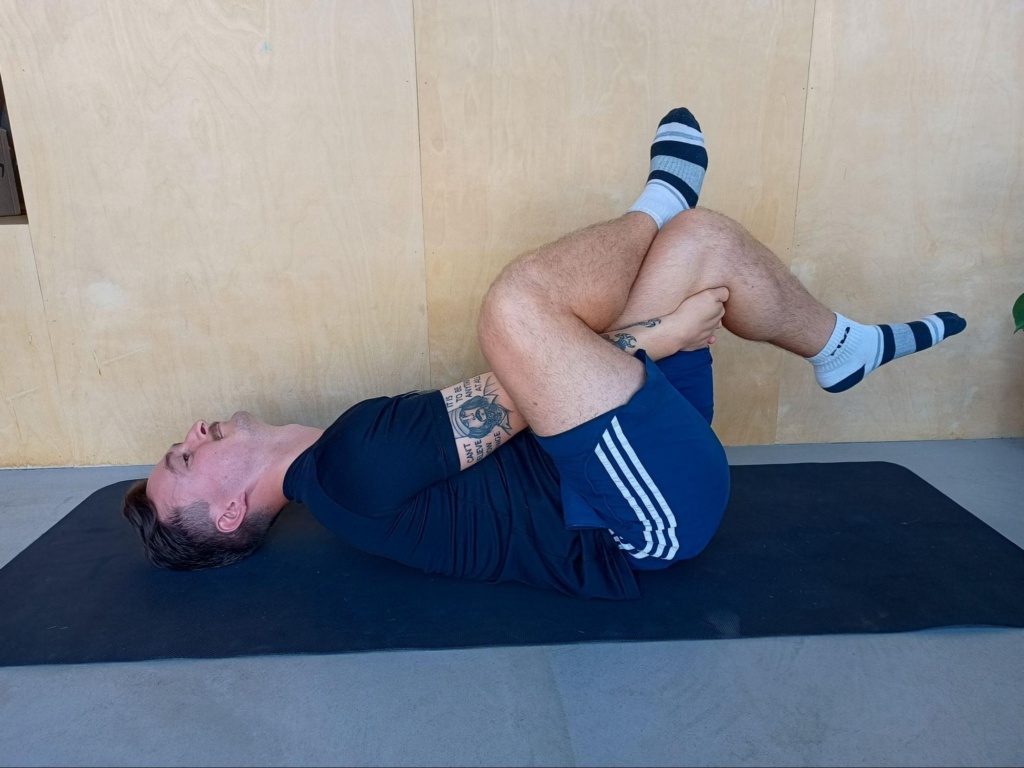
- Lie on your back on a flat surface, with both knees bent and feet flat on the ground.
- Cross one leg over the other by placing the ankle just above the knee on the opposite thigh.
- Gently pull the thigh of the uncrossed leg towards your chest, holding it either behind the thigh or on top of the knee.
- Hold the stretch for 20-30 seconds, feeling a gentle pull in the buttocks and hip of the crossed leg.
- Slowly release and switch legs to repeat the stretch on the other side.
- Ensure the stretch is comfortable and avoid any jerking or forceful pulling. This stretch should be a gentle, gradual extension, not a strain
Consistency is key with these exercises. Incorporating them into your daily routine will gradually help in correcting and improving your posture. Remember, if any exercise causes pain, stop immediately and consult a healthcare professional.
Professional Help for Posture Correction
Correcting and improving posture is a gradual process that requires consistency and dedication. While the tips and exercises provided in this article are a great starting point, they are part of a larger picture. Posture correction is a journey best navigated with professional guidance.
If you’re experiencing discomfort, chronic pain, or simply want to improve your posture for better health, Benchmark Physio can help. With our Posture Screening, our expert physiotherapists will use cutting-edge technology and advanced screening tools to meticulously assess how you move, identifying those critical underlying issues that contribute to poor posture.
Don’t let poor posture hold you back. Take the first step towards a healthier, more balanced life. Contact us today at Benchmark Physiotherapy, and let’s work together to create a posture improvement plan that works for you.







